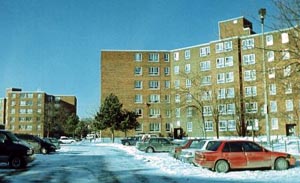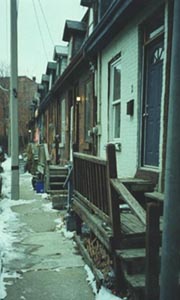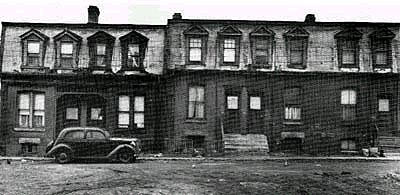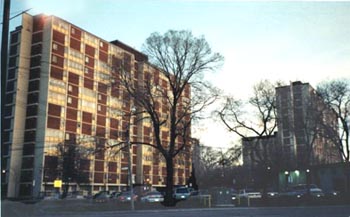The End Of Cabbagetown
|
|
|
A Typical Cabbagetown Street
My earliest Cabbagetown memories are of
the large house I was born in on busy Sherbourne Street. We had the
whole second floor of this once stately home except for the back room
which was occupied by someone called the Chinaman. We didn't see much
of him and I don't remember him at all, but I assume he was Chinese.
We had access to the large backyard since we knew the people living
on the main floor. My fondest memory of this place is of the large
front facing upstairs veranda which was entirely ours. Many relatives
and family friends would drop by on warm summer nights and my brother
would drag out his huge record player and spin everybody's 78's.
These records would run the gamut from Hank Williams to Rosemary
Clooney, with The Weavers' Goodnight Irene getting several spins per
night. There were other kids living in this place to play with and I
have nothng but fond memories of this time.
|
|
Typical Flatroof Rowhouses Of Cabbagetown
I don't know why we left that happy
place, but we did, and landed in the cramped upstairs flat of 117
River Street. An old Scottish couple named Scott owned the place and
they had a Scottish terrier called Scottie. I thought that was kind
of cool at the time, but as I look back it seems a bit on the goofy
side now. There was no backyard, veranda or kids, and no noise was
the house rule. Because we had to be so quiet, very few visitors
dropped by and my brother's record player was never played above a
whisper. Having nothing else to do I spent my time there sitting at
our kitchen window and watching the dock workers across the lane at Dominion Silk Mills. One
truck would pull in and get emptied and then another backed in and
was loaded, mighty exciting stuff for a young kid. Fortunately, we didn't live
in this boring place too long.
From there we moved into a run down old
house at 19 Belshaw Avenue. This was the first time we had a whole
house to ourselves and we made full use of it with a cat and a dog.
Not only did we have a porch and backyard, but the street was full of
kids. I even had my own tree to climb, although I almost lost it in
1954 when Hurricane Hazel ripped through Toronto. My brother's record
player once again roared to life and our friends started to fill the
house like before. We spent the next four years here with the winds
of change swirling around us and we waited to see what they'd
bring.
We heard our parents discussing it. We
heard it on the radio and saw it on TV. The broom of Urban Renewal
was about to sweep accross our neighbourhood and wipe out all the
drafty old houses and replace them with brand new homes and apartment
buildings. Being so young, we didn't clearly understand the concept
of the total destruction of a neighbourhood. It finally sunk in one
day when my family was watching "You Are There" on TV and pictures of
bombed out buildings in Europe flashed across the screen. My father
told me that Cabbagetown would soon look like that. I now
understood.
Not long after this, the bulldozers,
steamshovels and pile drivers descended on Cabbagetown like a herd of
cast iron Godzilla monsters. They began unceremonously gobbling up
and crushing everything in their path while grinding out an
incredible noise. The destruction was swift and sure. Our little dead
end street was one of the last to go, so we sat there as if an island
in a sea of devastation. First the townhouses seemed to pop up around
our island and the larger families moved into them. I even remember
that the Archer's, who lived across the street from us, were the
first family to move into South Regent Park. It was written up in all
the newspapers as if it were some major event. Then floor by floor,
we we watched these giant brick and mortar buildings rising up to try
and touch the clouds.
|
|
Large Buildings In Regent Park South
It only took a couple of years but
suddenly Cabbagetown was full of brand new buildings and now called
Regent Park South. The upper half of Cabbagetown above Dundas and
streching to Gerrard had been started earlier and was called North
Regent Park. The architectural differences between North and South
were about as extreme as they could be. The buildings in the north
looked more like something out of the 1920's, whereas the south had a
very modern looking design.
Many of the tiny streets disappeared
and the ones that remained had fancy names tacked on to the end of
them. My street, Belshaw Avenue which was moved over a block, became
Belshaw Place, Sackville St. became Sackville Green, St. David Street
became St. David Walk, and so on. I guess the City figured fancy
street names meant a fancy neighborhood.
In 1958 we moved into the first of the
five brand new 14 story buildings at 63 Belshaw Place and watched
them tear down our old house and the remaining bits of Cabbagetown
from our 10th floor window and turn it into parking lots, townhouses
and apartment buildings that all looked the same. That closed the
books on the first edition of Cabbagetown.
Although we now lived in Regent Park
South, we still called it Cabbagetown as did those that lived in
Regent Park North.
The Very Old Looking Buildings

Of Regent Park North
Calling All Old Cabbagetowners
in the 50's and 60's
and you have a story or pictures you would like posted here
Get a hold of me via
If it's suitable, I'll put it up.



